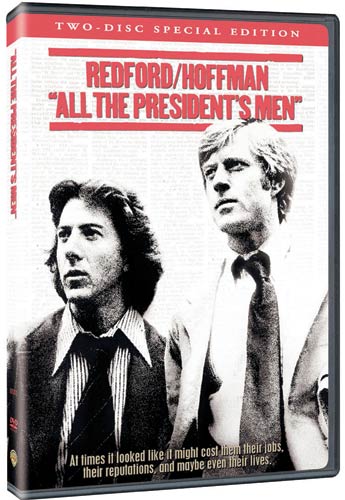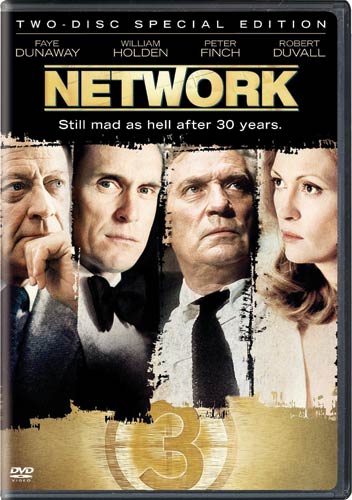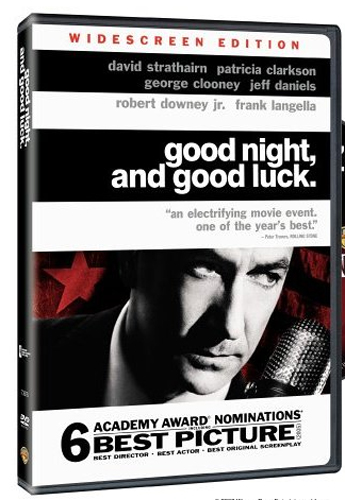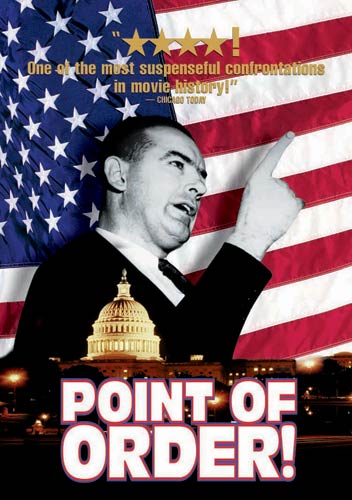BY PAUL MALCOM
Every decade, at least one movie about the media emerges to speak to its specific time–more often than not, it seems, because no one heeded the lessons or warnings of the films that came before. And yet, those movies that stand the test of time are only about the media secondarily. At the core of these enduring films are neither networks nor corporations but people faced with a choice we're all asked to make at some point in our lives: To stand with principle or take the easier road. It's the fundamental stuff of great storytelling. If there's any doubt that the debate about who we are as a nation and a culture plays out in the workings of the media, pick up today's newspaper. That's why filmmakers keep returning to these stories.
ALL THE PRESIDENT'S MEN (1976)
 The film that did more for journalism school enrollment than a thousand Pell Grants, All the President's Men is constructed as much around space as it is around the reporters who brought down a sitting president. Director Alan J. Pakula repeatedly defies convention by burying Robert Redford and Dustin Hoffman, as Woodward and Bernstein, in wide shots of the Washington Post editorial room, transforming his stars into two points amid a fluorescent field of ceiling lights and cubicles. It's a compositional strategy Pakula carries over to location shots all over Washington D.C., where Woodward and Bernstein pursue leads in the Watergate break-in operating as distant, determined figures moving through labyrinthine spaces, most famously in the film's series of high, floating dissolves from above the reading room of the Library of Congress. In reducing his characters' relative scale, Pakula concentrates their purpose. "They're hungry," Post metro editor, Harry Rosenfeld (Jack Warden), tells managing editor, Howard Simons (Martin Balsam). Pakula shows us just how hungry they were and gave investigative journalism its most significant big-screen crusaders. This two-disc special edition release features several vintage extras as well as and new making-of documentaries and an audio commentary by Redford. (Warner Home Video)
The film that did more for journalism school enrollment than a thousand Pell Grants, All the President's Men is constructed as much around space as it is around the reporters who brought down a sitting president. Director Alan J. Pakula repeatedly defies convention by burying Robert Redford and Dustin Hoffman, as Woodward and Bernstein, in wide shots of the Washington Post editorial room, transforming his stars into two points amid a fluorescent field of ceiling lights and cubicles. It's a compositional strategy Pakula carries over to location shots all over Washington D.C., where Woodward and Bernstein pursue leads in the Watergate break-in operating as distant, determined figures moving through labyrinthine spaces, most famously in the film's series of high, floating dissolves from above the reading room of the Library of Congress. In reducing his characters' relative scale, Pakula concentrates their purpose. "They're hungry," Post metro editor, Harry Rosenfeld (Jack Warden), tells managing editor, Howard Simons (Martin Balsam). Pakula shows us just how hungry they were and gave investigative journalism its most significant big-screen crusaders. This two-disc special edition release features several vintage extras as well as and new making-of documentaries and an audio commentary by Redford. (Warner Home Video)
NETWORK (1976)
 Thirty years ago, in the opening shot of Network, director Sydney Lumet could represent the full extent of the television news landscape by showing a fictional newsroom with just four television screens and one crazed newsman. Today, he and screenwriter Paddy Chayefsky would need a lot more of both. The mergers, mutations and deregulations that have reconfigured the media over the last three decades have made Network appear even more prescient. No one yet, that we know of, has been killed for having lousy ratings, as in the strange case of Howard Beale (Peter Finch), but since the film's release, the real world walls separating news and entertainment have crumbled to dust. Embodied by veteran newsman Max Schumacher (William Holden, in one of his best performances) and young up-and-comer Diana Christensen (Faye Dunaway), glitz seduces integrity. Lumet extends the tension between the two into the design of the film, pitting the naturalism that shapes the story's human drama against the decidedly anti-human spectacle of "The Howard Beale Show." In so doing, he extends the choice faced by the film's characters to the audience. Which do you prefer, Lumet asks, as if he and Chayefsky hadn't already seen the writing on the wall. This two-disc special edition release features a six-part anniversary documentary. (Warner Home Video)
Thirty years ago, in the opening shot of Network, director Sydney Lumet could represent the full extent of the television news landscape by showing a fictional newsroom with just four television screens and one crazed newsman. Today, he and screenwriter Paddy Chayefsky would need a lot more of both. The mergers, mutations and deregulations that have reconfigured the media over the last three decades have made Network appear even more prescient. No one yet, that we know of, has been killed for having lousy ratings, as in the strange case of Howard Beale (Peter Finch), but since the film's release, the real world walls separating news and entertainment have crumbled to dust. Embodied by veteran newsman Max Schumacher (William Holden, in one of his best performances) and young up-and-comer Diana Christensen (Faye Dunaway), glitz seduces integrity. Lumet extends the tension between the two into the design of the film, pitting the naturalism that shapes the story's human drama against the decidedly anti-human spectacle of "The Howard Beale Show." In so doing, he extends the choice faced by the film's characters to the audience. Which do you prefer, Lumet asks, as if he and Chayefsky hadn't already seen the writing on the wall. This two-disc special edition release features a six-part anniversary documentary. (Warner Home Video)
A FACE IN THE CROWD (1957)
 A Face in the Crowd fizzled at the box office in 1957 but today it is the post-war film perhaps most deserving of a coveted "We Told You So" Award. Director Elia Kazan and screenwriter Budd Schulberg update the lessons of Frank Capra's Meet John Doe (1941) for the television age to devastating effect, while drawing an early bead on the dangerous meeting of Madison Avenue and politics. As in On the Waterfront (1954), Kazan is at pains to illustrate the personal dilemma at the heart of this domestic threat to democratic institutions. In this case it's radio reporter Marcia Jeffries' long-festering crisis of conscience after playing a crucial role in catapulting plain-spoken "man of the people" Lonesome Rhodes (Andy Griffith) from an Arkansas drunk tank to the demagogic heights of a popular national television show. From the very first scenes after her discovery of Rhodes, Kazan starts closing in on Patricia Neal as Jeffries. Almost imperceptibly, frames grow tighter and shadows gather in the corners around her as she watches her creation take monstrous shape. As Rhodes, Griffith is a pure force of nature. Under Kazan's direction, he continues to gather intensity until the film's final shots when he breaks in one of the screen's most chilling existential howls. (Warner Home Video)
A Face in the Crowd fizzled at the box office in 1957 but today it is the post-war film perhaps most deserving of a coveted "We Told You So" Award. Director Elia Kazan and screenwriter Budd Schulberg update the lessons of Frank Capra's Meet John Doe (1941) for the television age to devastating effect, while drawing an early bead on the dangerous meeting of Madison Avenue and politics. As in On the Waterfront (1954), Kazan is at pains to illustrate the personal dilemma at the heart of this domestic threat to democratic institutions. In this case it's radio reporter Marcia Jeffries' long-festering crisis of conscience after playing a crucial role in catapulting plain-spoken "man of the people" Lonesome Rhodes (Andy Griffith) from an Arkansas drunk tank to the demagogic heights of a popular national television show. From the very first scenes after her discovery of Rhodes, Kazan starts closing in on Patricia Neal as Jeffries. Almost imperceptibly, frames grow tighter and shadows gather in the corners around her as she watches her creation take monstrous shape. As Rhodes, Griffith is a pure force of nature. Under Kazan's direction, he continues to gather intensity until the film's final shots when he breaks in one of the screen's most chilling existential howls. (Warner Home Video)
BROADCAST NEWS (1987)
 At first glance, Broadcast News may not seem to have the satiric bite of Network. But for all of the film's apparent lightness of touch, it delivers a more damning and incisive portrait of the television news industry. A former news writer for CBS, director-writer James L. Brooks depicts the professional and social rituals of a major network news operation as a grown-up version of the high school pecking order–only with much better dialogue. In Brooks' newsroom-cum-locker room, the empty-headed but handsome anchor, Tom Grunick (William Hurt) rises to the top, while the brilliant but nerdy reporter, Aaron Altman (Albert Brooks), always gets picked last for the team. Like the class president who slacks off in her senior year, Holly Hunter's whip smart producer, Jane Craig, buzzes with efficient energy until Grunick asks her to "the prom," in this case the correspondents dinner. Then all bets, personal and professional, are off. Like Lumet and Chayefsky before him, Brooks presents the seduction of serious news people by encroaching glitz, not as a sudden assault but a gradual, even pleasurable winning-over. As Altman tells Craig in the film's most electric scene, it's the strategy of the devil or at the very least, the prettiest boy in class. (20th Century Fox Home Video)
At first glance, Broadcast News may not seem to have the satiric bite of Network. But for all of the film's apparent lightness of touch, it delivers a more damning and incisive portrait of the television news industry. A former news writer for CBS, director-writer James L. Brooks depicts the professional and social rituals of a major network news operation as a grown-up version of the high school pecking order–only with much better dialogue. In Brooks' newsroom-cum-locker room, the empty-headed but handsome anchor, Tom Grunick (William Hurt) rises to the top, while the brilliant but nerdy reporter, Aaron Altman (Albert Brooks), always gets picked last for the team. Like the class president who slacks off in her senior year, Holly Hunter's whip smart producer, Jane Craig, buzzes with efficient energy until Grunick asks her to "the prom," in this case the correspondents dinner. Then all bets, personal and professional, are off. Like Lumet and Chayefsky before him, Brooks presents the seduction of serious news people by encroaching glitz, not as a sudden assault but a gradual, even pleasurable winning-over. As Altman tells Craig in the film's most electric scene, it's the strategy of the devil or at the very least, the prettiest boy in class. (20th Century Fox Home Video)
GOOD NIGHT, AND GOOD LUCK (2005); POINT OF ORDER (1964)

 Although Good Night, and Good Luck unfolds almost entirely within the CBS news studios of Edward R. Murrow, director and co-writer George Clooney and his creative team, including cinematographer Robert Elswit and production designer James D. Bissell, nail the political atmosphere of America circa 1954. If you don't believe it, take a look at director Emile de Antonio's 1964 documentary, Point of Order. Constructed entirely of black-and-white television footage of the Army-McCarthy hearings, de Antonio's "theater of the real," as he called his approach, reveals in the rawest terms the air of paranoid thuggery exuded by Senator Joseph McCarthy in his confrontations with U.S. Army Special Council Joe Welch. An obvious reference point for Clooney and his team (some of the McCarthy footage in Good Night was taken from de Antonio's film), Point of Order captures one of the most resonant media moments of the twentieth century: Welch's famous retort to McCarthy's bullying, "At long last sir, have you no sense of decency?" For all of Clooney's attention to period detail, however, Good Night, and Good Luck never feels nostalgic. It moves with an immediacy that gives the film so much of its present-tense power at a time, again, in need of good people willing to stand up. (Warner Home Video; New Yorker Video)
Although Good Night, and Good Luck unfolds almost entirely within the CBS news studios of Edward R. Murrow, director and co-writer George Clooney and his creative team, including cinematographer Robert Elswit and production designer James D. Bissell, nail the political atmosphere of America circa 1954. If you don't believe it, take a look at director Emile de Antonio's 1964 documentary, Point of Order. Constructed entirely of black-and-white television footage of the Army-McCarthy hearings, de Antonio's "theater of the real," as he called his approach, reveals in the rawest terms the air of paranoid thuggery exuded by Senator Joseph McCarthy in his confrontations with U.S. Army Special Council Joe Welch. An obvious reference point for Clooney and his team (some of the McCarthy footage in Good Night was taken from de Antonio's film), Point of Order captures one of the most resonant media moments of the twentieth century: Welch's famous retort to McCarthy's bullying, "At long last sir, have you no sense of decency?" For all of Clooney's attention to period detail, however, Good Night, and Good Luck never feels nostalgic. It moves with an immediacy that gives the film so much of its present-tense power at a time, again, in need of good people willing to stand up. (Warner Home Video; New Yorker Video)